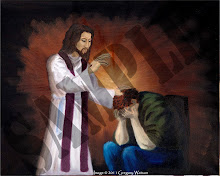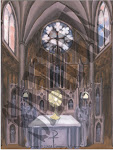O truly necessary sin of Adam,Eric asked whether I would take up the subject with our friend, and I said I'd write up this blog in order to try to dissect this wonderfully troubling portion of the greatest of all Nights.
destroyed completely by the Death of Christ!
O happy fault
that earned so great, so glorious a Redeemer!
Our friend's problem stemmed primarily from the phrase "O happy fault", saying that this could be taken out of context in order to justify sinning, or in some way saying that sinning was itself "happy". His argument is very much in keeping with St. Paul's words in Romans. In chapter 5, St. Paul makes an argument for the super-abundant greatness of God's mercy for us in Jesus Christ--contrasting Adam's sin with Christ's free gift of salvation. He concludes with these words:
Therefore, as by the offence of one, unto all men to condemnation; so also by the justice of one, unto all men to justification of life. For as by the disobedience of one man, many were made sinners; so also by the obedience of one, many shall be made just. Now the law entered in, that sin might abound. And where sin abounded, grace did more abound (Romans 5:18-20).It is, in fact, this reasoning, and this passage of Scripture, that is distilled by the exsultet into the paradox above quoted.
However, our friend's argument echoed St. Paul's next words in Romans chapter 6:1-2, "What shall we say, then? shall we continue in sin, that grace may abound? God forbid. For we that are dead to sin, how shall we live any longer therein?" In other words, our friend worried that the exsultet could be taken as celebrating Adam's sin and calling it good in such a way that it sets an example for us--the very argument that St. Paul decries in Romans 6.
Is this conclusion regarding the exsultet warranted? I would say absolutely not! When we examine the entirety of this great hymn, we recognise that the overall theme is the abolition of sin and slavery to it by the Death and Resurrection of Christ. Consider these lines, which appear just a few strophes before the part in question:
This is the nightSo, far from allowing or even encouraging a libertine attitude toward sin, the message of the exsultet is that the grace of God available to us through the Death and Resurrection of Jesus actually removes us from sin and vice and makes us holy!
that even now, throughout the world,
sets Christian believers apart from worldly vices
and from the gloom of sin,
leading them to grace
and joining them to his holy ones.
On the other side of the "O happy fault", a few strophes afterward, is stated,
The sanctifying power of this nightAgain, the exsultet, indeed, all of Easter and the totality of the Catholic faith is about the forgiveness of sins, the restoration to innocence, and the complete sanctification that comes when we cooperate with the tremendous Graces that Christ merited for us through the Cross and Resurrection!
dispels wickedness, washes faults away,
restores innocence to the fallen, and joy to mourners,
drives out hatred, fosters concord, and brings down the mighty.
But of course, my friend makes the claim that the "happy fault" portion could be understood without regard to the context we've just established, so none of the arguments above actually touch on his concern. So what does this portion mean in and of itself? Let's examine it again:
O truly necessary sin of Adam,A few things must be considered here, of a poetical and philosophical nature. For starters, the exsultet is a hymn, that is, it's a poem. It's not intended to be understood precisely in terms of a laboriously spelled-out theological treatise (as, for example, this blog might be!), but as an imaginative expression of a Mystery that ultimately lies beyond our comprehension. More simply put, reading poetry requires a very different mindset than reading prose. Poetry relies on symbolic shorthand, allusions, and creative wording (such as the very paradox we are considering) to shock our imaginations into considering Truth from a wholly new perspective. G.K. Chesterton sums up the contrast by saying that the poet tries to get his head into the heavens, whereas the rationalist tries to get the heavens into his head--and it is his head that splits! This attitude is echoed at the beginning of the exsultet, when the deacon or priest intones, "Lift up your hearts," and the congregation responds, "We lift them up to the Lord."
destroyed completely by the Death of Christ!
O happy fault
that earned so great, so glorious a Redeemer!
The second aspect to keep in mind is the philosophical language employed, particularly here, in the exsultet. That is, certain terms need to be understood in the very specific way they are meant, rather than in the general way we might use them in ordinary conversation--particularly the terms "necessary" and "happy".
O truly necessary sin of Adam,
destroyed completely by the Death of Christ!
Many people have a misunderstanding of Christ's redemption of our sins. That misunderstanding lies in the fact that they think that the incarnation, passion, death, and resurrection of Jesus constituted God's "Plan B" for creation. In other words, people often assume that the original, perfect state of Adam and Eve before the Fall was "Plan A" and then when Adam and Eve sinned and were booted from Eden, God had to come up with a "Plan B" to undo the damage. When the exsultet calls Adam's sin "necessary", it intends to completely undercut this mistaken notion.
There's a huge mystery here: that ponderous mystery of God's predestination and how it ties in to our free will. While God never actively wills sin and disobedience, He made the option possible in order that we could freely choose to love Him instead. Yet Adam and Eve's decision was never unknown to God, nor was the outcome. From all eternity God knew that His rational creatures would choose to rebel against Him, and His divine plan incorporated Adam's sin from the very foundations of the world, as we see in Revelation 13:8, where we are told that Christ, the Lamb, was slain "from before the foundation of the world." The Incarnation was not Plan B. God becoming Man so that we could participate in the divine life of God through His superabundant Grace was the idea all along! In this way, Adam's sin is understood as "necessary". If Adam and Eve never fell, Christ would never have needed to come. And so God allowed the loss of perfect human bliss through the original sin of Adam and Eve in order to bring about a greater, divine bliss for humanity (cf. 2 Peter 1:4)! Because there was a Fall, all of us recognise a lack in our lives. Because God only allows evil to occur in order to bring about a greater good (as St. Augustine reminds us), the fulfilment of the lack we feel because of the Fall goes far beyond even restoring us to that Edenic state! God never goes backwards. He's not taking us back to Eden. He is doing a new thing; the same New Thing He has been unfolding from all eternity; the same New Thing that unfolded at the Cross and was confirmed in the Resurrection, and which is consummated in us through His Graces to us, especially our rebirth in Baptism and our sustaining in holiness through the gift of Himself in the Eucharist!
O happy fault
that earned so great, so glorious a Redeemer!
Because, in this light, we see that Adam's sin was in some mysterious way "necessary", we can understand how his fault was a "happy" one. Philosophically speaking, "Happiness" is not simply some emotional state of contentment with life. Rather, it is the result of something or someone being rightly ordered to its true purpose. As St. Augustine writes in his Confessions, "Thou hast made us for thyself, O Lord, and our hearts are restless until they rest in Thee." It is that rest that constitutes "happiness", in the sense in which Adam's fault is here called "happy". And, of course, the reason for that happiness is expressed in the next line, because it "earned so great, so glorious a Redeemer!" In and of itself, sin, even Adam's sin, is not happy, nor does sin lead to happiness. In fact, sin is the cause of the restlessness that St. Augustine describes. Yet Adam's sin is "happy" in one and only one regard--because it was necessary to bring about the Incarnation of Jesus, and His glorious gift of Salvation through it--a Salvation that will ultimately take us far beyond what Adam and Eve lost for us in the Fall!
So, what can we conclude? Does the exsultet somehow promote sinfulness "so that grace may abound"? Absolutely not! The theme is the redemption men and the destruction of sin and its power. If we take the "Oh happy fault" out of context, can we arrive at a different conclusion? I suppose we could. If someone can take the very words of Christ in order to twist them to say precisely the opposite, they can take and twist anything. St. Peter warns us that there are those who twist even the words of Scripture to their own destruction! For the person who does not want to listen to the Truth, who refuses to "think with the mind of the Church" (sentire cum ecclesia, as St. Ignatius of Loyola put it), then they could take anything to justify their sinful lifestyle. They have not "lift[ed] up [their] hearts" to the Lord after all.
Is it then the Church's fault? Has She used "irresponsible language" in the exsultet? I suppose that depends on whether Jesus Himself used irresponsible language when He said many of the things He said that were misunderstood, and which have been taken out of context by our modern culture to justify their sins ("Judge not, lest ye be judged" anyone?).
Knowing the Truth, thinking with the mind of the Church, and lifting our hearts to the Lord are the keys to understanding the exsultet, and, indeed, all of the Christian faith, correctly.
God bless
Gregory








